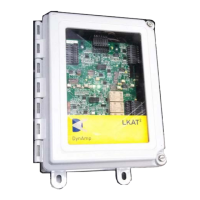Installation, Operation and Service Manual LKAT
2
+24V
© 2018 DynAmp, LLC Page 27
046404 E
5.12 “FAILSAFE” / “NON-FAILSAFE” CONFIGURATION
The LKAT
2
System relay outputs are failsafe as factory configured. When the system is
energized, all relay coils are energized and all contacts change state; that is, open contacts
close and closed contacts open. During any alarm condition, relay coils de-energize, which
changes the state of the relay contacts.
In the failsafe configuration, loss of input power to the LKAT
2
Metering Unit de-energizes the
alarm relay coils. This causes the relay contacts to change state and indicate an alarm
condition.
For some applications, the user requires that Trip1 to be “non-failsafe”. That is, the system
should not produce an alarm when there is loss of input power. Alarm conditions other than
loss of input power must continue to result in an alarm. Trip1 relay contacts can be configured
for Non-Failsafe operation. AD relay contacts are failsafe only. Trip2 and Trip3 relay contacts
(present on optional PE PCB assembly) are failsafe only.
Table 5.4 shows the status of the LKAT
2
alarm relay contacts. The alarm relay contact
condition is shown as it exists at the customer connections to the metering unit.
To convert the LKAT
2
System Trip1 to non-failsafe operation requires modification of the
Main pc board assembly, and modification of an internal wiring harness. Contact factory.
Refer to the Main pc board assembly drawing at the end of this manual.
Table 5.4
LKAT
2
Alarm Relay Status
(As found at Customer Connection to Metering Unit)
Non-Failsafe Metering Unit Configuration
Alarm
Name
Contact Set
POWER
OFF
POWER ON
NORMAL
ALARM
Trip2 P9-6 to P9-8 Closed Open Closed
P9-6 to P9-7 Open Closed Open
Trip3 P9-3 to P9-5 Closed Open Closed
P9-3 to P9-4 Open Closed Open
Trip1
P3-6 to P3-8
Open
Open Closed
P3-6 to P3-7
Closed
Closed Open
AD P3-3 to P3-5 Closed Open Closed
P3-3 to P3-4 Open Closed Open

